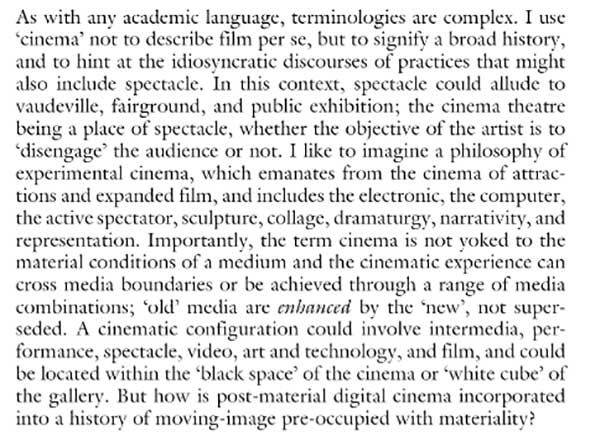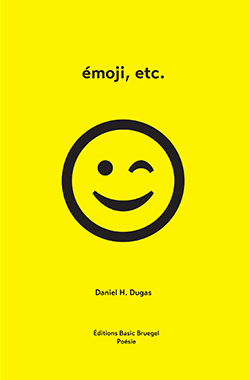Nomenclator

Nomenclator
Sorte d’huissier introducteur ; esclave qu’entretenaient chez les Romains les grands personnages, et qui avait pour fonction de retenir les noms et de connaître les traits de tous ceux qui avaient coutume de se présenter chez leur maître, de sorte que, quand celui-ci rencontrait dans la ville quelques-uns de ses clients, le nomenclator qui l’accompagnait lui indiquait leurs noms et le mettait en état de leur faire à chacun un compliment particulier. Car passer auprès du client sans lui faire politesse, même par inadvertance, aurait pu être regardé comme une insolence qu’on aurait peut-être payée cher aux élections suivantes (Cic. ad Att. IV, 1 ; Senec. Ep. 27).
************************************************************************************************************************
Sydney Smith – Square peg in a round hole
“Square peg in a round hole” is an idiomatic expression which describes the unusual individualist who could not fit into a niche of their society.
The metaphor was originated by Sydney Smith in “On the Conduct of the Understanding”, one of a series of lectures on moral philosophy that he delivered at the Royal Institution in 1804–06:
If you choose to represent the various parts in life by holes upon a table, of different shapes,—some circular, some triangular, some square, some oblong,—and the person acting these parts by bits of wood of similar shapes, we shall generally find that the triangular person has got into the square hole, the oblong into the triangular, and a square person has squeezed himself into the round hole. The officer and the office, the doer and the thing done, seldom fit so exactly, that we can say they were almost made for each other.
************************************************************************************************************************
Bernard Noël, le rôle du poète
Sans doute vaut-il mieux partir du fait que la société actuelle n’assigne aucun rôle à la poésie que, généralement, elle ignore. En conséquence, la poésie doit se fortifier de ce qui la nie et tirer de cette présence négative un nouveau souffle. D’ailleurs pourquoi est-elle ainsi reléguée? Parce quelle n’appartient pas à l’univers médiatique même s’il peut arriver qu’un poète y soit momentanément considéré. La raison de cette mise à l’écart est simple : la poésie ne saurait parler le langage simplificateur de la consommation sans y perdre sa nature, et elle ne saurait être lue sans contester la passivité qu’engendre cette simplification. Cela étant, faire acte de poésie, c’est aujourd’hui faire un acte de résistance à l’avilissement de l’intériorité par des stéréotypes qui, sous prétexte de démocratie, stérilisent l’émotion et l’imagination tout en privant de sens la pensée. Un produit conçu pour tous est forcément un produit insignifiant selon les critères de la consommation. La poésie, donc, est d’emblée inconsommable parce quelle a besoin, comme l’amour, d’un effort d’attention pour qu’advienne le partage. Sa signification est dans la qualité qu’elle rend alors au langage et, par lui, à la relation humaine…
************************************************************************************************************************
John Berger, Ways of seeing
Capitallsm survives by forcing the majority, whom it exploits, to define their own interests as narrowly as possible. This was once achieved by extensive deprivation. Today in the developed countries it is being achieved by imposing a false standard of what is and what is not desirable.
************************************************************************************************************************
José Ortega Y Gasset, being
There is the same difference between a pain that someone tells me about and a pain that I feel as there is between the red that I see and the being red of this red leather box. Being red is for it what hurting is for me. Just as there is an I-John Doe, there is also an I-red, an I-water, and an I-star. Everything, from a point of view within itself, is an I.
************************************************************************************************************************
José Ángel Leyva, poésie, carriérisme, visibilité, invisibilité
Quand les poètes deviennent trop visibles, et ça arrive, la poésie a tendance à disparaître. Ils augmentent le volume des pages pensées, pas pour donner à voir, mais pour se faire remarquer. Ils ont alors l’habitude de se soucier davantage de leur notoriété et de leur reconnaissance, que de la fidélité à leurs besoins expressifs. Le marché et les politiques culturelles exigent prix et hommages, presse et vie publique de ceux qui cherchent des modes de survie économique et intellectuelle.
UN ESSAI DE JOSÉ ÁNGEL LEYVA
Fracas – Octobre 2018
************************************************************************************************************************
William S. Burroughs
“We’re not fighting for a scrap of sharecropper immortality with the strings hanging off it like Mafioso spaghetti. We want the whole tamale. The Johnsons are taking over the Western Lands. We built it with our brains and our hands. We paid for it with our blood and our lives. It’s ours and we’re going to take it. And we are not applying in triplicate to the Immortality Control Board. Anybody gets in our way we will get our communal back against a rock or a tree and fight the way a raccoon will fight a fucking dog.”
― William S. Burroughs, The Place of Dead Roads
************************************************************************************************************************
Eddie Adams, photographer
Photography by its nature is selective. It isolates a single moment, divorcing that moment from the moments before and after that possibly lead to adjusted meaning.
Eddie Adams’ iconic Vietnam War photo: What happened next (BBC News, 29 January 2018)
************************************************************************************************************************
James Baldwin, artist, process
The artist is distinguished from all other responsible actors in society — the politicians, legislators, educators, and scientists — by the fact that he is his own test tube, his own laboratory, working according to very rigorous rules, however unstated these may be, and cannot allow any consideration to supersede his responsibility to reveal all that he can possibly discover concerning the mystery of the human being. Society must accept some things as real; but he must always know that visible reality hides a deeper one, and that all our action and achievement rest on things unseen. A society must assume that it is stable, but the artist must know, and he must let us know, that there is nothing stable under heaven. One cannot possibly build a school, teach a child, or drive a car without taking some things for granted. The artist cannot and must not take anything for granted, but must drive to the heart of every answer and expose the question the answer hides.
https://www.brainpickings.org/2014/08/20/james-baldwin-the-creative-process/
************************************************************************************************************************
Amadou Hampâté Bâ, Mémoire
En Afrique, quand un vieillard meurt, c’est une bibliothèque qui brûle.
************************************************************************************************************************
Qu’est-ce que la littérature électronique?
De la poésie, de la fiction ou tout oeuvre littéraire qui dépend du comportement, de l’aspect visuel et des propriétés matérielles propres aux ordinateurs, aux réseaux informatiques et aux codes pour sa composition, son exécution et sa réception.
Ce que j’aime de cette définition tripartite, je suppose, c’est que je crois qu’elle arrive à capter les rôles mutuels des auteur, lecteur et machine, de même que des aspects des ordinateurs à titre de plateforme, d’écran et de média. (Bien sûr, d’autres questions se posent, comme ce qu’est la littérature et ce qu’est un ordinateur.)
Matthew G. Kirschenbaum
http://nt2.uqam.ca/fr/actualites/quest-ce-que-la-litterature-electronique
************************************************************************************************************************
Jannis Kounellis , form
If you take drama away from form you are left with formalism. Without drama, art becomes merely an industrial affair.
Everything needs to be centred on humanity
Martin Gayford 17 FEBRUARY 2017
************************************************************************************************************************
Hannah Arendt, politque, espoir
Que nous ayons, même dans les plus sombres des temps, le droit d’attendre quelque illumination et qu’une telle illumination puisse fort bien venir moins des théories et des concepts que de la lumière incertaine, vacillante et souvent faible que des hommes et des femmes, dans leur vie et leur oeuvre, font briller dans presque n’importe quelles circonstances et répandent sur l’espace de temps qui leur est donné sur terre, telle est l’ultime conviction qui constitue le fond sur lequel les silhouettes qui suivent furent dessinées.
Hannah Arendt, Vies politiques
************************************************************************************************************************
Experimental Film and Video: An Anthology
by Jackie Hatfield (Editor), Stephen Littman (Editor)
John Libbey Publishing, 2006
ISBN: 978-0-86196-906-7
************************************************************************************************************************
Hildegard Westerkamp, soundwalk
When going for a walkis replaced by going for a drive-which happens more frequently than we may think-our contact with nature becomes purely visual: on the windshield two-dimensional landscapes appear; we are watching a film about landscapes to the soundtrack of a running motor or of music and voices from radio, cassette or CD; our visual experience is mediated by what we hear and our aural experience has no relationship to what we see. The contact that is made between environment and human senses is defined by the “skin” or bubble of the vehicle in which we sit.
Soundwalking By Hildegard Westerkamp originally published in Sound Heritage, Volume III Number 4, Victoria B.C., 1974 Revised 2001 published in: Autumn Leaves, Sound and the Environment in Artistic Practice, Ed. Angus Carlyle, Double Entendre, Paris, 2007, p. 49.
************************************************************************************************************************
Desert Thryptomene
Aluta maisonneuvei
Myrtaceae

************************************************************************************************************************
Les Levine, video
If I only have one life to live, let me live as a video tape.
************************************************************************************************************************
Heidegger, screens
Despite what one might expect from a phenomenologist like Heidegger, his objection is not that the aesthetic view mischaracterizes the way we late moderns ordinarily experience “art.” On the contrary, Heidegger clearly thinks that what he characterizes as “the increasingly aesthetic fundamental position taken toward art as a whole” (N1 88/GA43 103) does accurately describe the experiences of art that take place—when they do take place—in museums, art galleries, and installations; in performance spaces, theaters, and movie houses; in cathedrals, coliseums, and other ruins; in cityscapes as well as landscapes; in concert halls, music clubs, and comic books; even when we listen to our speakers, headphones, ear-buds; and, sometimes (who could credibly deny it?), when we sit in front of our television screens, computer monitors, iPhones, and so on. The experiences we have of what rises to the level of “art” in all such settings are indeed “aesthetic” experiences, that is, particularly intense or meaningful experiences that make us feel more alive; and, if we think about it, we do tend to approach these art objects as expressions of the life of the artists who created them. The aesthetic view correctly characterizes our typical experience of “art” in the contemporary world—and for Heidegger that is part of the problem.[18]
2.2 Heidegger’s Critique of the Aesthetic Approach
************************************************************************************************************************
The Last of England, painting, Ford Madox Brown
In order to mirror the harsh conditions in the painting Brown worked mostly outside in his garden, and was happy when the weather was poor — he recorded his feelings of delight when the cold turned his hand blue, as this was how he wanted it to appear in the painting. He was seen as strange by his neighbours who saw him out in all kinds of weather. He composed a short verse to accompany the painting in which the woman is depicted as hopeful for the future:
…She grips his listless hand and clasps her child,
Through rainbow tears she sees a sunnier gleam,
She cannot see a void where he will be.
************************************************************************************************************************
Michelangelo Pistoletto, art, museum
“Don’t imagine there’s room for everyone in the museum. Perhaps for a few who are really interested in it. But there is room for everyone in other places. You can use art in all sorts of ways. Society needs you”
************************************************************************************************************************
Borges, art, the task of art
The task of art is to transform what is continuously happening to us, to transform all these things into symbols, into music, into something which can last in man’s memory. That is our duty. If we don’t fulfill it, we feel unhappy. A writer or any artist has the sometimes joyful duty to transform all that into symbols. These symbols could be colors, forms or sounds. For a poet, the symbols are sounds and also words, fables, stories, poetry. The work of a poet never ends. It has nothing to do with working hours. Your are continuously receiving things from the external world. These must be transformed, and eventually will be transformed. This revelation can appear anytime. A poet never rests. He’s always working, even when he dreams. Besides, the life of a writer, is a lonely one. You think you are alone, and as the years go by, if the stars are on your side, you may discover that you are at the center of a vast circle of invisible friends whom you will never get to know but who love you. And that is an immense reward.
************************************************************************************************************************
Bill Evans, music, discovery
When you play music you discover a part of yourself that you never knew existed.
https://twitter.com/Bill_Evans_Trio
************************************************************************************************************************
Deborah Kerr, Yul Brynner
Major Surov: Anything goes when people meet for the last time.
Diana Ashmore: What do you mean?
Major Surov: Go to any railway station – that’s what I mean. You’ll see people doing things they’d never do, ordinarily. They kiss, they cry, they wave. That’s the sickness of our time: people waving… Nobody waves back.
************************************************************************************************************************
Küppers, couleur, sémiologie
Alors que l’homme peut en général distinguer 10 000 nuances colorées environ, son vocabulaire ne lui fournit qu’une douzaine de termes différents: noir, blanc, gris, bleu, jaune, rouge, vert et brun sont les désignations essentielles qui forment la base de ce vocabulaire.
Harald Küppers, La couleur, Fribourg, Office du livre, 2975, p.15
************************************************************************************************************************
de Tocqueville, opinion, savoir
Si l’homme était forçé de se prouver à lui-même toutes les vérités dont il se sert chaque jour, il n’en finirait point; il s’épuiserait en démonstrations préliminaires sans avancer; comme il n’a pas le temps, à cause des bornes de son esprit, d’en agir ainsi, il est réduit à tenir pour assurés une foule de faits et d’opinions qu’il n’a eu ni le loisir ni le pouvoir d’examiner et de vérifier par lui-même, mais que de plus habiles ont trouvés ou que la foule adopte. C’est sur ce premier fondement qu’il élève lui-même l’édifice des ses propres pensées. Ce n’est pas sa volonté qui l’amène à procéder de cette manière; la loi inflexible de sa condition l’y contraint.
Il n’y a pas de si grand philosophe dans le monde qui ne croie un million de choses sur la foi d’autrui, et qui ne suppose beaucoup plus de vérités qu’il n’en établit.
Ceci est non seulement nécessaire mais désirable. Un homme qui entreprendrait d’examiner tout par lui-même ne pourrait accorder que peu de temps et d’attention à chaque chose; ce travail tiendrait son esprit dans une agitation perpétuelle qui l’empêcherait de pénétrer profondément dans aucune vérité et de se fixer avec solidité dans aucune certitude. Son intelligence serait tout à la fois indépendante et débile. Il faut donc que, parmi les divers objets des opinions humaines, il fasse un choix et qu’il adopte beaucoup de croyances sans les discuter, afin d’en mieux approfondir un petit nombre dont il s’est réservé l’examen.
Il est vrai que tout homme qui reçoit une opinion sur la parole d’autrui met son esprit en esclavage; mais c’est une servitude salutaire qui permet de faire un bon usage de la liberté.
Alexis de Tocqueville, De la Démocratie en Amérique, Tome II.
************************************************************************************************************************
Pascal,
L’homme, par exemple, a rapport à tout ce qu’il connaît. Il a besoin de lieu pour le contenir, de temps pour durer, de mouvement pour vivre, d’éléments pour le composer, de chaleur et d’aliments pour se nourrir, d’air pour respirer ; il voit la lumière, il sent les corps ; enfin tout tombe sous son alliance. Il faut donc, pour connaître l’homme, savoir d’où vient qu’il a besoin d’air pour subsister ; et pour connaître l’air, savoir par où il a ce rapport à la vie de l’homme. La flamme ne subsiste point sans l’air ; donc pour connaître l’un, il faut connaître l’autre. Donc toutes choses étant causées et causantes, aidant et aidantes, médiatement et immédiatement, et toutes s’entretenant par un lien naturel et insensible qui lie les plus éloignés et les plus distantes, je tiens impossible de connaître les parties sans connaître le tout non plus que de connaître le tout sans connaître particulièrement les parties.
Blaise Pascal, Pensées – Section II
# 72 Disproportion de l’homme
************************************************************************************************************************
Beauvois et Ghiglione, langage
Le langage est, en quelque sorte, abordé comme « le véhicule transparent des intentions, des attitudes…, un simple outil de transmission des informations qui circulent sans résistance d’un système cognitif à l’autre » (Beauvois et Ghiglione, 1981).
L’analyse du discours assistée par ordinateur, Pascal Marchand, p. 13.
************************************************************************************************************************
Ducrot, langage
Comprendre un discours, c’est toujours imaginer des stratégies.
Oswald Ducrot, 1980.
************************************************************************************************************************
Bakhtine, langage
…. l’homme communicant est co-constructeur de la réalité, et non son miroir réfléchissant (Ghiglione). De même que pour observer le processus de la combustion, il convient de placer le corps dans le milieu atmosphérique, de, même pour observer le phénomène de langage, il faut placer les sujets émetteur et récepteur du son, ainsi que le son lui-même, dans le milieu social (Bakhtine, 1929, p. 73) »
************************************************************************************************************************
Neruda, writing, typewriter
Ever since I had an accident in which I broke a finger and couldn’t use the typewriter for a few months, I have followed the custom of my youth and gone back to writing by hand. I discovered when my finger was better and I could type again that my poetry when written by hand was more sensitive; its plastic forms could change more easily. In an interview, Robert Graves says that in order to think one should have as little as possible around that is not handmade. He could have added that poetry ought to be written by hand. The typewriter separated me from a deeper intimacy with poetry, and my hand brought me closer to that intimacy again.
The Paris Review
Interviews: Pablo Neruda, The Art of Poetry No. 14
Interviewed by Rita Guibert
http://www.theparisreview.org/interviews/4091/the-art-of-poetry-no-14-pablo-neruda
************************************************************************************************************************
Zombie, film, transformation
In addition to these creatures of legend, there is another folk-tale figure of horror who keeps turning up in movies: the zombie, or walking dead, who was born in the tales told by Africans who were brought to the Caribbean islands to toil as slaves.
The legends describe the zombie as a dead man brought back to life – but life in a particularly unpleasant and freighting kind. The zombie is tireless, working endlessly without food or sleep. He cannot be hurt by any weapon, and he cannot feel pain; when hit by a bullet, the zombie simply does not pay attention. He obeys his master’s command without question, and the only way to destroy the zombie is by total elimination. Until that day, he is the total slave of his master – usually a wizard who has created the zombie by a form of black magic or voodoo.
It is easy to see how this legend originated. Working conditions for black slaves often were so terrible that many did come close to being the blindly obedient, endlessly working creatures that a zombie is supposed to be. A dash of superstition helped the legend alive even after the end of slavery.
The zombie theme has not been as popular in the movies as the legend of the vampire or the werewolf, perhaps because it is more difficult to make a zombie look terrifying. A vampire can be outfitted with a full set of fangs and a werewolf can be as hairy and toothy as anyone wants, but a zombie usually is just a man with a blank expression. In addition, the zombie is a creature who works hard all day and all night, while werewolves and vampires spend their time not at work but at play – if you care to call stalking human prey a form of play. Children who work in school all day and adults who work in businesses all day would rather watch a vampire at play than a zombie at work; at least, that is what the box office results seems to say. And so zombie movies have not been too successful.
Edelson, Edward, Great Monsters of the Movies (New York, An Archway Paperback, 1974) p. 12-14.
************************************************************************************************************************
Pascal, mouvement
Les grands et les petits ont mêmes accidents, et mêmes fâcheries, et même passions ; mais l’un est au haut de la roue, et l’autre près du centre, et ainsi agité par les mêmes mouvements.
Blaise Pascal, Pensées et Opuscules. 180 – Pensées – Section II
************************************************************************************************************************
S. Donald Stookey, CorningWare
“Stookey was a young scientist researching the properties of glass … when he put a glass plate into an oven to heat it. But the oven malfunctioned. Instead of heating to about 1,100 degrees Fahrenheit, the oven shot up to more than 1,600 degrees. Stookey expected to find a molten mess. Instead, he found an opaque, milky-white plate. As he was removing it from the oven, his tongs slipped, and the plate fell to the floor. But instead of shattering, it bounced.”
From: Scientist Who Invented CorningWare Glass Dies At 99
************************************************************************************************************************
saint Augustin, parole, image
Les hommes qui sont obligés de se servir de la parole pour découvrir leurs pensées n’expriment qu’une seule chose à la fois. Mais si je pouvais m’exprimer autrement, je dirais d’un seul mot tout ce que je pense.
saint Augustin
************************************************************************************************************************
Lionel Casson, multimillionnaires, ‘fishpond set’
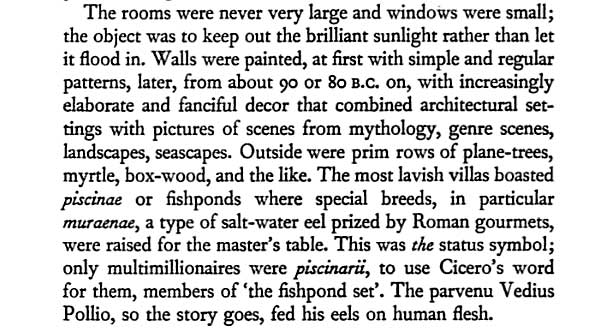
Lionel Casson, Travel in the Ancient World, Georges Allen & Unwin Ltd 1974, p. 141
************************************************************************************************************************
Shaw, disco, music
Around ’75 when the recession hit, club owners started going to disco because it was cheaper for them to just buy a sound system than it was to hire a band.
Tommy Shaw
************************************************************************************************************************
Beckett, life
There’s my life, why not, it is one, if you like, if you must, I don’t say no, this evening. There has to be one, it seems, once there is speech, no need of a story, a story is not compulsory, just a life, that’s the mistake I made, one of the mistakes, to have wanted a story for myself, whereas life alone is enough.
Beckett, Samuel. “Texts for Nothing,” The Complete Short Prose 1929-1989. pg 116.
************************************************************************************************************************
Aragon, Triolet

Une Société qui existe depuis 2004. Elle a une relation privilégiée avec la Société des amis de Louis Aragon et Elsa Triolet (SALAET) qui œuvre depuis des années, en France, pour la mémoire et la promotion de ces deux écrivains.
http://www.agota.be/aragon/biblio2.html
Système Dd (page 6-10)
************************************************************************************************************************
Susan Rudy, BioBlitz
The term “BioBlitz” was first coined in 1996 by U.S. National Park Service naturalist Susan Rudy and is used to describe an intense period of biological surveying. Generally occurring over a 24-hour period, a BioBlitz aims to record as many species of plants, animals, microbes, fungi, and other organisms as possible within a designated area. Public participation is often key as expert scientists and naturalists lead teams in order to raise public consciousness regarding biodiversity.
http://mappingmeaning.wordpress.com/2014-2/
************************************************************************************************************************
Kristeva, Images médiatiques, émotions, uniformisation de l’âme.
« pressés par le stress, impatients de gagner et de dépenser, de jouir et de mourir, les hommes et les femmes d’aujourd’hui font l’économie de cette représentation de leur expérience qu’on appelle une vie psychique… L’homme moderne est en train de perdre son âme. Mais il ne le sait pas, car c’est précisément l’appareil psychique qui enregistre les représentations et leurs valeurs signifiantes pour le sujet. »
Les Nouvelles Maladies de l’Âme
Julia Kristeva
************************************************************************************************************************
Derrida, archive, Hanold/Gradiva
Il veut exhumer une impression, il veut exhiber une empreinte plus archaïque que celle autour de laquelle s’affairent les autres archéologues de toute sorte, ceux de la littérature et ceux de la science objective classique, une empreinte chaque fois singulière, une impression qui ne soit presque plus une archive mais se confonde avec la pression su pas qui laisse sa marque encore vivante sur un support, une surface, un lieu d’origine. Quand le pas vient faire encore un avec le subjectile.
À l’instant où l’empreinte n’est pas encore laissée, abandonnée par la pression de l’impression.
Jacques Derrida, Mal d’Archive, p.150
L’archiviste produit de l’archive et c’est pourquoi l’archive ne se ferme jamais. Elle s’ouvre depuis l’avenir.
Jacques Derrida, Mal d’Archive, p.109
************************************************************************************************************************
O’Connor, writing
Everywhere I go I’m asked if I think the university stifles writers. My opinion is that they don’t stifle enough of them. There’s many a bestseller that could have been prevented by a good teacher.
– Flannery O’Connor
http://en.wikipedia.org/wiki/Flannery_O%27Connor
************************************************************************************************************************
Serres, publicité, éducation
[…] la fonction pédagogique est aujourd’hui assurée plus par les affiches, la publicité et les médias de tous ordres que par l’école.
J’ai mis un bonnet rouge au vieux dictionnaire
Le 05 décembre 2013
Michel Serres
http://www.academie-francaise.fr/dire-ne-pas-dire
************************************************************************************************************************
Finlay, colour, belief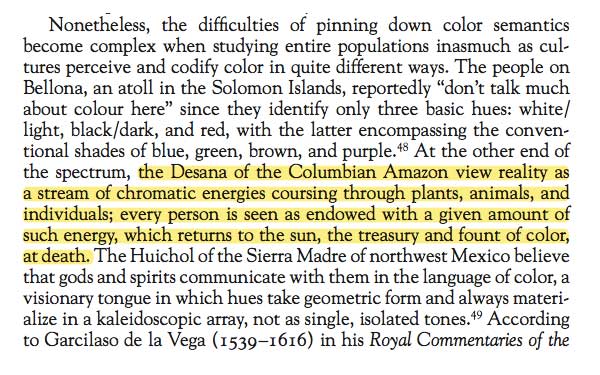
Robert Finlay, Weaving the Rainbow: Visions of Color in World History
Journal of world history, december 2007, p. 396
************************************************************************************************************************
Wittgenstein, life, death
Death is not an event in life: we do not live to experience death. If we take eternity to mean not infinite temporal duration but timelessness, then eternal life belongs to those who live in the present. Our life has no end in the way in which our visual field has no limits.
Wittgenstein, Tractatus, 6.431
************************************************************************************************************************
Brad Leithauser, poetry, Peter Kane Dufault, careerism
In the course of his life, Dufault was an amateur boxer, a fencing enthusiast, a tree skinner, a Washington lobbyist, a newspaperman, a housepainter, a fiddler, a dance caller, a combat airman in North Africa during the Second World War, and a Liberal Party candidate for Congress running on an anti-Vietnam War platform. What he wasn’t was an academic. This was fine by me. He seemed an antidote to what I saw as an emerging professionalization and careerism: poetry executives. I sometimes fear that we’ll soon enter a world where most creative young people will carry under their arm not only a poetry manuscript but an accompanying seven- or eight-page C.V., cataloguing every symposium and colloquium they’ve attended, every elementary-school classroom and open-mic bar and poetry-retreat picnic where they’ve recited their verse. Dufault was, by contrast, a slapdash self-promoter. He was insouciant and catch-as-catch-can. His books cried out for a proofreader. His letters and postcards were a mad, winsome scramble of scribbles. I asked him once why he’d left out a lovely little poem, “Wintersong,” from his selected works. (I’d found it in an old New Yorker.) “Guess it slipped my mind,” he told me, contentedly.
From: Brad Leithauser: Postscript: Peter Kane Dufault (1923-2013), June 7, 2013, The New Yorker
************************************************************************************************************************
Saul Bass, graphic, titles
My initial thoughts about what a title can do was to set mood and the prime underlying core of the film’s story, to express the story in some metaphorical way. I saw the title as a way of conditioning the audience, so that when the film actually began, viewers would already have an emotional resonance with it.
Haskins, Pamela (Autumn 1996). “Saul, Can You Make Me a Title? Interview with Saul Bass”. Film Quarterly. pp. 12-13.
************************************************************************************************************************
Walter Benjamin, mémoire
… la mémoire n’est pas seulement un instrument qui servirait à la reconnaissance du passé, mais qu’elle en est plutôt le médium. Elle est le médium du vécu, comme le sol est le médium dans lequel les villes antiques gisent ensevelies. Celui qui cherche à se rapprocher de son propre passé enseveli doit se comporter comme un homme qui fait des fouilles.
Walter Benjamin, Denkbilder, éd R. Tiedemann et H. Schweppenhäuser, IV-1, Francfort, Suhrkamp, 1972, p. 400-4001 (Georges Didi-Huberman, Ce que nous voyons, ce qui nous regarde, p. 131)
*
Language has unmistakably made plain that memory is not an instrument for exploring the past, but rather a medium. It is the medium of that which is experienced, just as the earth is the medium in which ancient cities lie buried. He who seeks to approach his own buried past must conduct himself like a man digging.
Selected Writings, Vol. 2, part 2 (1931–1934), ”Ibizan Sequence”, 1932,
ed. by Marcus Paul Bullock, Michael William Jennings, Howard Eiland, and Gary Smith, Cambridge, Mass.: Belknap Press of Harvard University Press, 2005 (paper), p. 576
************************************************************************************************************************
Georges Didi-Huberman, art, image
Nous sommes devant les images comme devant d’étranges choses qui s’ouvrent et se ferment alternativement à nos sens – que l’on entende dans ce dernier mot un fait de sensation ou un fait de signification, le résultat d’un acte sensible ou celui d’une faculté intelligible.
Georges Didi-Huberman, L’image ouverte, Motifs de l’incarnation dans les arts visuels, Gallimard, 2007
************************************************************************************************************************
Georges Didi-Huberman, art, aura, critique
Le critique d’art se trouve en effet devant son propre vocabulaire comme devant un problème d’étincelles à produire de mots à mots, en frottant pour ainsi dire les mots avec des mots.
Georges Didi-Huberman, Ce que nous voyons, ce qui nous regarde, Les Éditions de Minuit, 1992, p 140
************************************************************************************************************************
Walter Benjamin, aura, critique, art
Trouver des mots pour ce qu’on a devant les yeux, comme cela peut être difficile. Mais, lorsqu’ils viennent, ils frappent le réel à petits coups de marteau jusqu’à ce qu’ils aient gravé l’image sur lui comme sur un plateau de cuivre.
Walter Benamin, Sens unique, p.317
************************************************************************************************************************
Walter Benjamin, mémoire, vestige
“(…) Car les véritables souvenirs ne doivent pas tant rendre compte du passé que décrire précisément le lieu où le chercheur en prit possession.”
Walter Benjamin, Denkbilder
************************************************************************************************************************
Robert Smithson, cinema, art
Some artists see an infinite number of movies. Hutchinson, for instance, instead of going to the country to study nature, will go to see a movie on 42nd Street, like “Horror at Party Beach” two or three times times and contemplate it for weeks on end. The movies give a ritual pattern to the lives of many artists, and this induces a kind of “low-budget” mysticism, which keeps them in a perpetual trance. The “blood and guts” of horror movies provides for their “organic needs.” Serious movies are too heavy on “values,” and so are dismissed by the more perceptive artists. Such artists have X-ray eyes, and can see through all of that cloddish substance that passes for “the deep and profound” these days.
from Selected writings by Robert Smithson: http://www.robertsmithson.com/essays/entropy_and.htm
voir aussi: Un Trou dans la vie: essais sur l’art depuis 1960
************************************************************************************************************************
Tony Smith, art, cube, nuit, route
« C’était une nuit sombre, et il n’y avait pas d’éclairage ni de signalisation sur les côtés de la chaussée, ni de lignes blanches, ni de glissières de sécurité, ni quoi que ce soit, rien que l’asphalte qui traversait un paysage de plaines entourées de collines au loin, mais ponctué par des cheminées d’usines, des pylones, des fumées et des lumières colorées. Ce parcours fut une expérience révélatrice. La route et la plus grande partie du paysage étaient artificiels, et pourtant on ne pouvait pas appeler ça une œuvre d’art. D’autre part, je ressentais quelque chose que l’art ne m’avait jamais fait ressentir. Tout d’abord, je ne sus pas ce que c’était, mais cela me libéra de la plupart des opinions que j’avais sur l’art. Il y avait là, semblait-il, une réalité qui n’avait aucune expression dans l’art. L’expérience de la route constituait bien quelque chose de défini, mais ce n’était pas socialement reconnu. Je pensais en moi-même : il est clair que c’est la fin de l’art.»
Citation de Tony Smith tirée de « Ce que nous voyons, ce qui nous regarde », Georges Didi-Huberman, Les Éditions de Minuit, Collection « Critique », p70
************************************************************************************************************************
in its own delight and glory and oddity and light.
by Dylan Thomas
************************************************************************************************************************
Meyer Shapiro, couleur
C’est une difficulté semblable que les couleurs nous opposent lorsque nous cherchons une raison universelle, transculturelle, à leur usage symbolique, quoiqu’elles soient pour nous fortement chargées d’émotion. Le blanc comme le noir est associé à la mort ; le bleu est un attribut du monde souterrain non moins que du ciel. Au cours de sa traversée de l’Asie centrale, Marco Polo nota que, dans une province de l’Inde, le noir avait la faveur et que l’on réservait au diable le blanc – tandis que les Tartares, de leur côté, n’aimaient rien de mieux que le blanc.
La conclusion que l’on tire habituellement de ces dissemblances – à savoir que le symbolisme des couleurs serait de part en part conventionnel – néglige le fait que la couleur est plus qu’une propriété élémentaire : c’est un complexe et de l’expérience ou de l’état d’esprit de celui qui regarde. Un bleu qui, comme couleur du ciel dans une peinture, paraît diaphane et doux peut sembler froid et dense dans une autre, comme couleur de l’enfer.
Meyer Shapiro, Les Mots et les images, pp. 120-121
************************************************************************************************************************
Robert McKee, image system
An image system is a strategy of motifs, a category of imagery embedded in the film that repeats in sight and sound from beginning to end with persistence and great variation, but with equally great subtlety, as a subliminal communication to increase the depth and complexity of aesthetic emotion.
Robert McKee, Story: Style, Structure, Substance, and the Principles of Screenwriting
It Books; 1 edition (Nov 13 1997) p 401
************************************************************************************************************************
Jean-Marie Klinkenberg, dénotation, connotation
Les choix permis par les jeux de la synonymie et de l’homonymie ne sont pas indifférents : ils sont eux-mêmes signifiants. Ce mécanisme particulier de signification a longtemps été décrit grâce aux notions de dénotation et de connotation. Nous en fournissons ici les définitions les plus classiques, avant d’en étudier les limites.
Soient quatre Belges à qui l’on propose une bière. Ils acceptent mais font un choix différent. Le premier réclame « une Jup », le second une Champigneulles, le troisième une Bofferding et le quatrième une Molson. Les quatre font certes la même chose : demander une bière. Mais leur demande est signifiante sur un autre plan. Les signes qu’ils ont émis nous renseignent sur la personnalité de ces buveurs et buveuses. Le premier affirme peut-être son patriotisme wallon par son choix ; le second est peut-être un francophile ; le troisième provient vraisemblablement de la Province du Luxembourg, et le quatrième est un insupportable snob qui veut faire croire que la meilleure bière se boit à Montréal, d’où il revient. On dira que leur choix a un sens premier, que l’on appellera la dénotation, mais qu’il s’en dégage des sens seconds : les connotations.
Jean-Marie Klinkenberg, Précis de sémiotique générale, Seuil, Collection Points Essais
2.2 Dénotation et connotation. p. 246
************************************************************************************************************************
Gilles Deleuze, agrammaticalités, style
Lorsque la langue est si tendue qu’elle se met à bégayer, ou à murmurer, balbutier…, tout le langage atteint à la limite qui en dessine le dehors et se confronte au silence. Quand la langue est ainsi tendue, le langage subit une pression qui le rend au silence. Le style – la langue étrangère dans la langue – est fait de ces deux opérations. […] Le style est l’économie de la langue. Face à face, ou face à dos, faire bégayer la langue, et en même temps porter le langage à sa limite, à son dehors, à son silence.
G. Deleuze, Critique et clinique. Paris : Minuit, 1993, p. 142.
Voir La stylistique deleuzienne et les petites agrammaticalités: http://stylistique-anglaise.org/document.php?id=345
************************************************************************************************************************
Émile Benveniste, texte/image
Le visage de profil est détaché de l’observateur et appartient, avec le corps en action (ou inerte et sans but), à un espace que les autres profils partagent sur la surface de l’image. Il correspond approximativement à la forme grammaticale de la troisième personne : le pronom « il » ou « elle », non spécifié, suivi de la forme verbale correspondante ; au lieu que le visage tourné vers l’extérieur paraît animé d’une intention, d’un regard latent ou potentiel dirigé vers le spectateur, et correspond au rôle du « je » dans le langage, associé au « tu » qui en est le complément obligé.
Émile Benveniste, « Sémiologie de la langue », in Essais de linguistiques générale, t. II, Paris, Gallimard, 1974, p 95
Cité in : Les mots et les images, Meyer Shapiro, in Préface, La peinture prise au mot, Hubert Damisch p 23
Voir, La peinture hollandaise du Siècle d’or dans le roman, Marie-Laurence Noël, p 34, http://bit.ly/XGIrT8
************************************************************************************************************************
Benjamin Franklin, schedule, routine

Productivity maniac Benjamin Franklin had a formidably rigorous daily routine. See also: http://www.brainpickings.org/index.php/2012/11/20/daily-routines-writers/
************************************************************************************************************************

Saint François d’Assise, foi
Un jour que les médecins allaient lui appliquer un fer rouge aux tempes, il le bénit d’abord et lui dit: «Feu, toi qui es mon frère, le Très-Haut t’a fait avant toutes choses, et t’a fait beau, utile et puissant ; sois-moi donc favorable aujourd’hui, et Dieu daigne adoucir ton ardeur de telle sorte que je puisse la supporter.» Le fer fut appliqué, et le saint s’écria : «Mes frères, louez avec moi le Très-Haut ; le feu même ne brûle pas, et je ne sens aucune douleur.»
Abrégé de l’histoire de Saint François d’assise Chapitre 12 1208-1226 p 175
************************************************************************************************************************
Hercules, Antaeus, Earth, Mythology

Hercules Slaying Antaeus, Hans Sebald Beham (1500-1550)
A celebrated exploit of Hercules was his victory over Antaneus. Antaneus the son of Terra, the Earth, was a mighty giant and wrestler whose strength was invincible so long as he remained in contact with his mother Earth. He compelled all strangers who came to his country to wrestle with him, on condition that if conquered (as they all were) they should be put to death. Hercules encountered him, and finding that it was of no avail to throw him, for he always rose with renewed strength from every fall, he lifted him up from the earth and strangled him in the air.
Myths of Greece and Rome, Thomas Bulfinch p 172
************************************************************************************************************************
Critique, jugement, art (Voltaire)
Les artistes sont les juges compétents de l’art, il est vrai, mais ces juges compétents sont presque toujours corrompus.
Un excellent critique serait un artiste qui aurait beaucoup de science et de goût, sans préjugés et sans envie. Cela est difficile à trouver.
Voltaire, Dictionnaire philosophique, Paris, Flammarion, GF, 1964,
************************************************************************************************************************
Hole, narrative techniques (B.S Johnson)

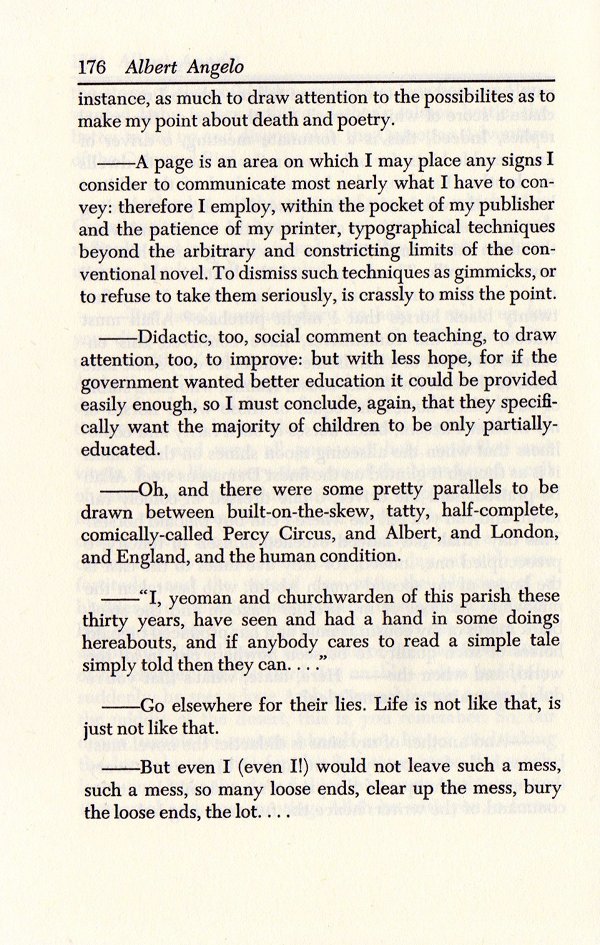
B.S. Johnson, Albert Angelo, New Directions Publishing Corporation, New York, 1964.

************************************************************************************************************************
Nomadism, tribe (Martin Johnson)
During the three days we spent among them, I picked up fragments of their history, which runs somewhat as follows: Years ago, before the white men came to Malekula, there were many more people on the island than there are today. In the north and in the south there were great tribes, who were fierce and warlike. They fell upon the people who dwelt in the isthmus, and destroyed their villages. Again and again this happened. The tribes that lived in the isthmus grew smaller and smaller. Their men were killed and their women were carried off. Finally the few that were left no longer dared to build villages; for a village served merely to advertise their whereabouts to their enemies. They became nomads, living in trees. They even ceased the cultivation of gardens and depended for their food on wild fruits and nuts, the roots of trees, and in occasional bit of fish. Their number was augmented from time to time by refugees from the Big Numbers tribes on the north and from the Small Numbers on the south – a fact that explained the variation in dress we had noticed. They were unarmed, because their best means of defense was flight. They could not stand against their warlike neighbors, but they could elude them by climbing trees and losing themselves in the dark, impenetrable jungles.
Cannibal-Land, Adventure with a camera in the New Hebrides, Martin Johnson, Chapter IX, The Monkey People, Houghton Mifflin Company, Boston, New York, 1922, p 136-137
http://archive.org/stream/canniballandadv00johngoog#page/n9/mode/2up
************************************************************************************************************************
Community (The Welfare State Handbook)
A barn dance alone is a social event which may confirm existing relationships within a community; it may even act as a quasi-ritual, allowing a community to confront and overcome its latent tensions. But only under exceptional circumstances can it act as a model for the development of a community through factors external to that community.
The Welfare State Handbook
************************************************************************************************************************
Bistro (Svetlana Boym)
One of the patriotic acts of the Moscow mayor was the creation of the first Russian fast-food chain. Luzhkov proposed “a healthy alternative to McDonald’s – the ‘traditional’ Russian Bistro.” The name, of course, is not accidental. Bistro, one of the few Russian words that penetrated European languages, means “quickly.” It is what victorious Russian soldiers are said to have shouted in Paris in 1814 when they marched here after the triumphant victory over Napoleon and needed some nourishment. The French adapted to the tastes of the soldiers and created a form of café that was later rediscovered back in Russia. There is little that is traditional, however, about the style of russian bistro; it is more American than French, but what matters is that the cabbage pirogi are homey and taste good, proving that Russian fast food is not a contradiction in terms.
The Future of Nostalgia, Svetlana Boym, p. 67.
************************************************************************************************************************
Nation, pieuvre, patriotisme (Romain Rolland)
La nation! Mais qui donc peut se dire le représentant d’une nation? Qui connaît, qui a seulement osé jamais regarder en face l’âme d’une nation en guerre? Ce monstre fait de myriades de vies amalgamées, diverses, contradictoires, grouillant dans tous les sens, et pourtant soudées ensemble, comme une pieuvre… Mélange de tous les instincts, et de toutes les raisons, et de toutes les déraisons… Coups de vent venus de l’abîme; forces aveugles et furieuses sorties du fond fumant de l’animalité; vertige de détruire et de se détruire soi-même; voracité de l’espèce; religion déformée; érections mystiques de l’âme ivre de l’infini et cherchant l’assouvissement maladif de la joie par la souffrance, par la souffrance de soi, par la souffrance des autres; despotisme vaniteux de la raison, qui prétend imposer aux autres l’unité qu’elle n’a pas, mais qu’elle voudrait avoir; romantiques flambées de l’imagination qu’allume le souvenir des siècles; savantes fantasmagories de l’histoire brevetée, de l’histoire patriotique, toujours prête à brandir, selon les besoins de la cause, le Væ victis du brenn, ou le Gloria victis… Et pêle-mêle, avec la marée des passions, tous les démons secrets que la société refoule, dans l’ordre et dans la paix… Chacun se trouve enlacé dans les bras de la pieuvre. Et chacun trouve en soi la même confusion de forces bonnes et mauvaises, liées, embrouillées ensemble. Inextricable écheveau. Qui le dévidera?… D’où vient le sentiment de la fatalité qui accable les hommes, en présence de telles crises.
Aux peuples assassinés, Romain Rolland – http://dormirajamais.org/rolland/
************************************************************************************************************************
Daniel H. Dugas
Archives
Blogroll
- A.I.R. Vallauris
- ACAD
- Adobe additional services
- Adobe Creative Cloud
- AIRIE
- Amaas
- Amazon Author Central
- ARTothèque
- Australian Poetry
- Basic Bruegel
- Bitly
- CCCA
- CDBaby
- Cycling 74
- Dissolution
- Éditions Prise de parole
- Emmedia
- eyelevelgallery
- FAVA
- Festival acadien de poésie
- Festival FRYE Festival
- FILE – Electronic Language International Festival
- Freeware list
- Fringe Online
- Galerie Sans Nom
- Gotta Minute Film Festival
- Instants Vidéo
- JUiCYHEADS
- Kindle Direct Publishing
- Klondike Institute of Art and Culture
- La Maison de la poésie de Montréal
- La Maison de la Poésie et de la Langue française Wallonie-Bruxelles
- Laboratorio Arte-Alameda
- Le Centre Jacques Cartier
- Liberated Words
- Maison Internationale de la Poésie – Arthur Haulot
- MediaPackBoard
- Miami Book Fair International
- Monoskop
- Mot Dit
- NSCAD University
- Paved Arts
- PoetryFilm
- Portail des auteurs du Nouveau-Brunswick
- RECF
- Revue Ancrages
- Salon du Livre du Grand Sudbury
- Sculpture Space
- Subtropics.org
- Sydney college for the arts
- The Centre for Contemporary Canadian Art
- The New Gallery
- Trevigliopoesia
- tumbler-documents
- V Tape
- Valerie LeBlanc
- VideoBardo
- Void Network-Κενο Δίκτυο
Categories
- #covidpoèmes
- Advertisement
- AIRIE
- Ancrages
- anthology
- Anthropocene
- Architecture
- Around Osprey
- art
- Article de presse
- arts visuels
- audio
- Australian Poetry
- Basic Bruegel Editions
- Book
- book fair
- Cafe Poet Program
- Ce qu'on emporte avec nous
- Citations gratuites
- Collaboration
- commentaire
- commentary
- Compte rendu
- conférence
- Conservation Foundation of the Gulf Coast
- COVID-19
- Critique littéraire
- culture
- Daniel Dugas
- Design
- Édition Michel-Henri
- Éditions Perce-Neige
- Éloizes
- Emmedia
- emoji etc | émoji etc
- Environnement
- essai
- essay
- Everglades
- Exhibition
- festival
- Festival acadien de poésie
- Festival Frye Festival
- FIPTR
- Flow: Big Waters
- Fundy
- Habitat
- installation
- Instants Vidéo
- interactivity
- journal
- JUiCYHEADS
- Kisii
- L'Esprit du temps
- laptop
- Leaving São Paulo
- lecture
- Livre
- logos
- Magazine
- Miami Book Fair
- Moncton 24
- novel
- OASIS
- oil spill
- perception
- performance
- Photo
- poésie
- Poetic Licence Week
- Poetry
- politics
- politique
- press
- Prise de parole
- Revue Ancrages
- salon du livre
- sculpture
- Sculpture Space
- sound
- Souvenirs
- Spirit of the Time
- Style & Artifacts
- Symposium d'art/nature
- talk
- television
- The New Gallery
- Uncategorized
- Valerie LeBlanc
- vidéo
- vidéopoésie
- Videopoetr/Vidéopoésie
- videopoetry
- visual arts
- What We Take With Us
- youth literature






